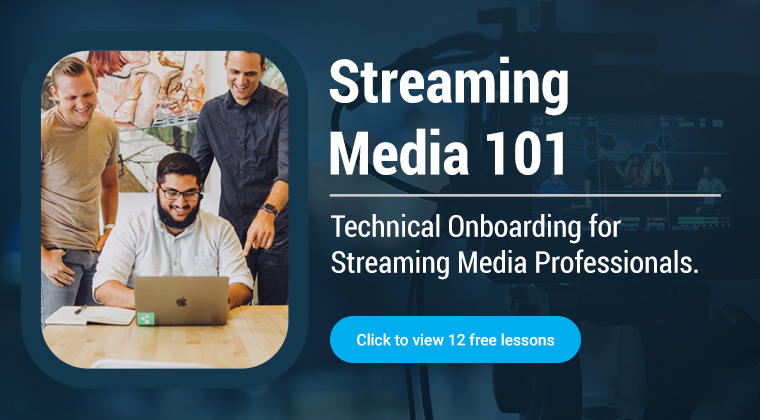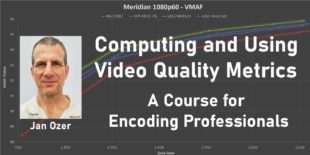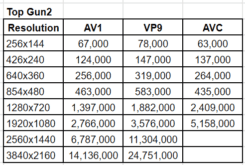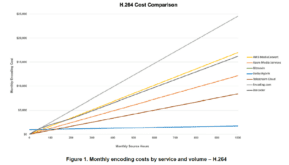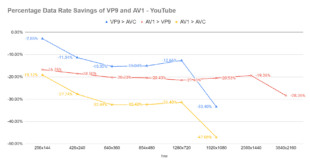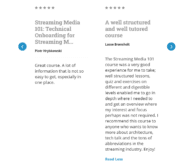I’ve been a fan of video optimization technologies for a while now, and consider optimization simpler, cheaper, and potentially just as effective as adding a new codec like HEVC or VP9. I’m pleased to see that the Crunch Mediaworks Video Enhancement Solutions App is now available on the Oracle Cloud Marketplace. I reviewed Crunch‘s technology back in 2019 for video …
Read More »Announcing Updates to Video Quality Metrics Course
Just a brief announcement that I’ve updated the course, Computing and Using Video Quality Metrics: A Course for Encoding Professionals, that teaches encoding professionals how to measure and apply metrics like VMAF, SSIMPLUS, MS SSIM, SSIM, and Apple’s AVQT. The updates include: Lessons on computing and applying Apple’s AVQT metric. A lesson on computing the weighted average bandwidth and quality …
Read More »Basic YouTube-DL Commands to Download Files from YouTube
This article describes what youtube-dl is, and outlines several basic youtube-dl commands for audio/video/subtitle downloads. I’ve always been fascinated with how YouTube encodes the endless hours of videos uploaded to the site. YouTube employs the best and the brightest and their task is positively Sisyphean. For years, I’ve gotten a glimpse of YouTube’s encoding practices via download tools like the …
Read More »New Course for Sales and Marketing Professionals New to Streaming Media
The course teaches the technology and market knowledge necessary to effectively market and sell streaming-related products and services Just a brief note to announce the Streaming Learning Center’s newest course, Streaming Media 101: for Sales and Marketing Professionals. The course provides the technology and market knowledge necessary for new marketing and sales hires to effectively market and sell streaming-related products …
Read More »Streaming Learning Center Releases Streaming Media 101: For Sales and Marketing Professionals
The course teaches the technology and market knowledge necessary to effectively market and sell streaming-related products and services Christiansburg, VA, October 1, 2021. The Streaming Learning Center today announced a new online course entitled Streaming Media 101: for Sales and Marketing Professionals. The new course teaches sales and marketing professionals new to streaming media the technology and market knowledge necessary …
Read More »Cloud Encoding Pricing Comparison Reveals Dramatic Cost Differences – Are You Overpaying?
This whitepaper, sponsored by Dolby/Hybrik, tracks cloud encoding pricing for H.264 and HEVC output and reveals dramatic price differences among popular services. I’ve just completed a whitepaper sponsored by Dolby/Hybrik to compare pricing for multiples of one hour of H.264 and HEVC encoding using the recommended encoding ladders in the Apple HLS Authoring Specifications. You can download the whitepaper here. …
Read More »Which Codec Does YouTube Use, Part III
This article analyzes the codecs used by YouTube for 4K videos with millions of views, and the savings that AV1 and VP9 deliver over YouTube’s full encoding ladder. This is the third in a series of articles written about which codecs YouTube uses. The first covers which codecs YouTube uses for high-volume 1080p videos. The second covers the codecs used …
Read More »Formulate the Optimal Encoding Ladder with VMAF
This post describes how to formulate the optimal encoding ladder with VMAF. This analysis is excerpted from a lesson in the online course Streaming Media 101: Technical Onboarding for Streaming Media Professionals. I received the following question from a reader; it’s got such general applicability that I thought I would share my response. Question: We’re currently reviewing our ABR ladder …
Read More »Another Five-Star Review for Streaming Production Course
I’m pleased to report another five-star review for the streaming production course Streaming Media 101: Technical Onboarding for Streaming Media Professionals. So far, the course has been taken hundreds of times with eleven reviews, all five stars. Here’s what the latest review, from Lasse Bronsholt, had to say. The Streaming Media 101 course was a very good experience for me …
Read More »Streaming Learning Center Presents Webinar on Remote Production Workflows
Webinar Highlights Three Remote Production Workflows to Enable Attendees to Choose the Best Alternative Here’s the webinar; links to the handouts are below the video window. Thanks to Corey, Anthony, and John for pulling together the information and delivering three great presentations. Corey’s handout here: Anthony’s handout here: John’s handout here: Here’s the description: Remote production became a “thing” during …
Read More » Streaming Learning Center Where Streaming Professionals Learn to Excel
Streaming Learning Center Where Streaming Professionals Learn to Excel

